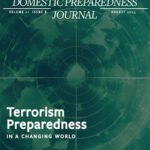For emergency management professionals, the hazards and risk associated with local, county, and state fairs mirror those of other high-attendance events—medical emergencies, mass casualty incidents, and other public safety risks. However, those familiar with the food and agriculture sector recognize an additional risk: the introduction and spread of animal diseases, which can have potentially catastrophic consequences for state, regional, and national economies.
Animal Movement and Risk Landscape
County and state fairs, rodeos, horse shows, races, and livestock shows are long-standing agricultural traditions that promote youth development and public education in the agricultural sciences. To facilitate these gatherings, hundreds or even thousands of animals are transported across states for purposes of entertainment, genetic showcasing, and athletic performance. For instance, major livestock events like the Houston Livestock Show and Rodeo, the National Western Stock Show in Denver, the Calgary Stampede in Canada, and the American Royal in Kansas City bring together large numbers of animals—approximately 30,000 at Houston, 12,000 at Denver, 7,500 at Calgary, and 6,000 in Kansas City. These multi-day events feature a wide array of animals and attract audiences numbering in the millions. However, the movement of these animals is independent of the millions of animals transported annually within the United States for the commercial agricultural purposes of breeding, grazing, auction, export, and processing.
States regulate transports to exhibitions through their departments of agriculture or related agencies tasked with animal health oversight. Animals destined for shows or other recreational events are often required to obtain a Certificate of Veterinary Inspection (CVI), or health certificate, before moving within or between states. CVIs provide information on the number of animals inspected, the purpose of movement, the points of origin and destination, and a statement by a USDA-accredited veterinarian confirming that the animals show no clinical signs of illness or parasites that would pose a risk at their destination.
Despite these health assessments, risks remain. Errors on health certificates are common and the requirement for certificates to be issued up to 30 days before movement may not account for changes to an animal’s health status post-inspection, for incubation periods of certain infectious diseases, or for the potential for subclinical signs of illness within a herd or specific animal. While most livestock producers and handlers are familiar with the health status of their animals, those raising livestock for exhibition purposes—at times outside traditional agricultural production—may have different priorities and risk tolerances, highlighting the critical need for strong biosecurity awareness, education, and practices at event sites.
A Look Back
Stringent biosecurity practices minimize the impact of animal disease spread, enabling future events to continue. Consider these recent event cancellations due to animal disease outbreaks:
- 2015: A Colorado horse show canceled due to Vesicular Stomatitis Virus (VSV).
- 2018: The Vancouver Island Rabbit Breeder Association show canceled following an outbreak of Rabbit Hemorrhagic Disease (RHD).
- 2019:
- The Salinas Valley Fair’s poultry exhibit was canceled due to Virulent Newcastle Disease.
- The World Pork Expo was canceled over African Swine Fever concerns—and again in 2020 for the same cause and the then emerging COVID-19 pandemic.
- Several high school rodeos in Utah were canceled over the concerns of equine herpes spread.
- 2021: The California Mid-State Fair postponed its rabbit show due to RHD.
- 2023: The Rancho Mission Viejo Rodeo canceled due to VSV concerns.
- 2024: The dairy exhibits at both the Big Fresno Fair and the Iowa State Fair canceled due to the transmission of highly pathogenic avian influenza (HPAI) in dairy herds.
The ongoing response to HPAI, a type of bird flu that spreads rapidly between and within both commercial and backyard flocks, began in January 2022 and has affected over 166 million birds to date. Its continued transmission not only within domestic flocks but also within dairy herds continues to raise concerns. Since its first identification in dairy cattle in March 2024, 976 cases have been reported across 17 states as of February 2025—California having the highest number of confirmed cases. This has resulted in the recent banning of poultry and dairy exhibitions this year at all county fairs and shows within the state. With ongoing transmission within both dairy and poultry production facilities, it is likely that cancellations will continue in 2025. It is worth noting, however, that these incidents are not unique to the United States.
In 2022, the National Poultry Show in Ontario, Canada, was canceled due to HPAI. More recently, in 2024, poultry exhibits in South Australia were also canceled in response to the HPAI outbreak. Additionally, the English Winter Fair in Staffordshire, England, and an annual sheep herding event in Madrid, Spain, were both canceled over bluetongue virus concerns. These are just a few examples highlighting the widespread impact of animal disease outbreaks on agricultural and livestock exhibition events across the world.
Understanding Disease Response: Why It Matters
A robust disease response involves detection, containment, eradication or control, and recovery. Delays or inadequacies in these stages can lead to widespread consequences that affect the economy, public health, and the food supply chain.
Livestock losses alone result in billions of dollars in damages, while canceled events and trade restrictions result in lost revenue and marketing opportunities. Zoonotic diseases like Salmonella, E. coli, HPAI, and others can originate in domestic animals and wildlife and pose direct threats to human health. These outbreaks can rapidly spread between animals, to humans, and vice versa, creating a cycle of transmission that disrupts food production and the supply chain. As a result, the availability and affordability of food products domestically and abroad exacerbate economic and public health challenges.
Collaboration and integration among stakeholders—including government agencies, producers, and trade associations—with both the authority and expertise to manage these intersectoral risks are crucial for effectively reducing consequences within and across affected sectors.
The Stakes for Future Agricultural Leaders and Professionals
Independent of the severe consequences associated with an animal disease outbreak—estimated in the tens of billions of dollars for animal diseases like foot-and-mouth and ASF—the cancellation or modification of these events across the United States may also disrupt vital opportunities for the next generation of agricultural leaders. Exhibition events provide valuable hands-on experience, education, and career development for youth, as well as opportunities to expose the general public to animal agriculture. For example, the Houston Livestock Show and Rodeo, one of the world’s largest livestock events, has awarded over $630 million in scholarships and support to youth since 1932, including nearly $25 million planned for 2025.
Exhibition Biosecurity Planning Considerations
According to the World Organization for Animal Health, biosecurity is the collection of management practices and physical measures aimed at minimizing the risk of introducing, establishing, or spreading animal diseases, infections, or infestations within, into, or out of an animal population. The risk of an animal disease outbreak and the subsequent biosecurity planning and infrastructure required at an event involving livestock are influenced by factors such as the species involved, the event size and scope, the season or time of year, and the effectiveness of preventive measures in place.
Effective biosecurity practices are essential to safeguarding the health of livestock, protecting public safety, and ensuring the success and continuation of exhibition events. By implementing robust biosecurity measures—such as exclusion, dedication (or segregation), and hygiene—event organizers, agricultural professionals, and exhibitors can minimize risks to both humans and animals and preserve the integrity of an event and the broader domestic livestock system. This section offers several biosecurity planning considerations for event planners at each stage.
Before the Event
- Restrict non-essential personnel, vehicles, and equipment; require health certifications, advanced screenings, and designated entry points for animals and materials.
- Assign separate zones for different species, quarantine areas for high-risk animals, and dedicated storage for feed, bedding, and equipment.
- Clean and disinfect facilities, equipment, and transport vehicles; install and maintain handwashing and boot-washing stations; train staff and exhibitors on biosecurity practices; and plan for proper disposal of contaminated materials.
During the Event
- Control access points with physical barriers, inspect animals for illness, and prohibit unauthorized equipment or feed without inspection.
- Segregate animal populations, provide dedicated tools and equipment, clearly label “clean” and “dirty” zones, and limit equipment sharing.
- Regularly disinfect high-contact areas, provide personal protective equipment, enforce handwashing and boot-washing protocols, and ensure adequate cleaning supplies are available.
- Establish clean communication channels among event organizers, participants, and relevant animal health personnel to report concerns, share biosecurity updates, and ensure compliance with protocols.
After the Event
- Conduct exit health checks, clean and disinfect vehicles leaving the premises, and properly dispose of contaminated materials like bedding and manure.
- Use dedicated tools and supplies for post-event cleanup and inspect equipment before returning it to general use.
- Thoroughly clean and disinfect all areas, vehicles, and equipment, and provide participants with guidelines for post-event animal health monitoring.
Additional considerations may include ongoing surveillance and access to veterinary staff throughout the event, feed safety and contamination prevention, waste management, dead stock removal, notification protocols, and movement permitting if illness or disease is identified. By offering biosecurity guidance before and after the event, along with clear instructions for reporting issues, and by integrating exclusion, dedication, and hygiene at every stage of the event cycle, planners can create effective biosecurity systems that minimize disease risks and ensure safety for all.
Looking Forward: A Shared Responsibility
As Western sport fans welcome the 2025 season and students and families everywhere eagerly anticipate upcoming exhibition events, it is imperative that agricultural and emergency management professionals and event planners are familiar with and remain vigilant regarding the ever-present risk and threat of animal disease introduction and transmission. By fostering cross-sector collaboration, implementing rigorous biosecurity protocols, and remaining watchful, exhibition planners can ensure the continued success of these events while safeguarding the opportunities they provide for future generations of agricultural leaders throughout the United States.
The views expressed in this article are solely those of the author and do not represent the views or positions of Sandia National Laboratories or the U.S. Department of Energy.
Additional contributions to this article were made by Adrian Self (Operations Research Analyst, National Agricultural Biosecurity Center at Kansas State University), David Hogg (Research Associate, Cooperative Institute for Server and High Impact Weather Research and Operations at the University of Oklahoma), and Marshal Wilson (Co-Director, Southwest Border Food Protection and Emergency Preparedness Center at New Mexico State University).

Joshua Dise
Joshua Dise is an interdisciplinary national security and emergency management professional with experience in both operational and analytical roles. His work addresses complex and interconnected risks, including industrial hazards, transboundary diseases, cybersecurity, and systemic threats to critical infrastructure. He currently serves as a systems analyst at Sandia National Laboratories, where he provides decision support on ill-defined, multi-domain national security challenges using a broad range of technical skills and expertise. Prior to this, he served as a lead technical analyst and emergency planner at Sandia, where he was responsible for delivering a variety of hazard analyses and consequence assessment products. His research interests include environmental hazard response, biosecurity, agricultural and public health preparedness, natural resource management and security, and the convergence of digital and physical infrastructure risks. Joshua holds advanced degrees in emergency management and natural resources and is currently a Ph.D. student at Oklahoma State University, studying fire and emergency management administration. He is also an alumnus of the National Preparedness and Leadership Initiative at Harvard University.
- Joshua Disehttps://www.domesticpreparedness.com/author/joshua-dise
- Joshua Disehttps://www.domesticpreparedness.com/author/joshua-dise
- Joshua Disehttps://www.domesticpreparedness.com/author/joshua-dise
- Joshua Disehttps://www.domesticpreparedness.com/author/joshua-dise





